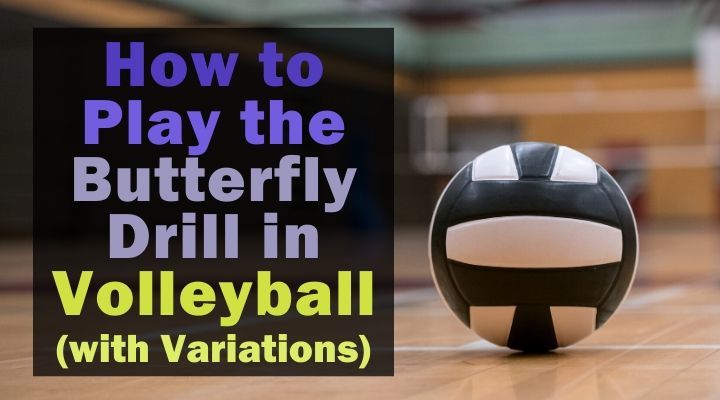How to Run the Butterfly Drill in Volleyball (with Variations)
The Butterfly Drill is well known by anyone who has played any form of organized volleyball.
It’s a versatile drill that can be used as a warmup or in practice to hone a variety of skills.
It can be altered to focus on serving, passing, or setting.
Coaches of all levels use the Butterfly Drill regularly and it's easy to learn.
Keep reading to find out how it can benefit you or your team, how to perform the drill in multiple formats, and more.

Benefits of the Butterfly Drill
We’ve already covered one of the best things about the butterfly drill - versatility.
The fact that the drill can be changed with minor tweaks and focus on so many aspects of the sport puts the Butterfly at the top of our list of favorite drills.
Passing is honed by requiring players to adjust to an incoming serve, overpass, or down ball.
Players will practice their ability to read an incoming ball, move their feet accordingly, and position their platform to provide a good pass to the target.
When having players serve, they’re gaining the valuable skill of serving to a specific target rather than just hoping to get the ball in bounds.
Younger players are also gaining experience using their wrist action and core strength to get the ball over the net and to the passer.
Coaches can have setters work on receiving the pass and setting to themselves or a target positioned in an area that does not inhibit the rest of the drill.
Setters need to gain experience taking live passes as often as possible.
The butterfly drill can be run quickly in a continuous motion or can be slowed down for focus on a particular area.
Let’s look at how the primary version of the drill runs.
How The Butterfly Drill in Volleyball Works
If you intend to run this as a continuous drill, it’s important to have the setter set the ball to herself and roll it to the next server in the serving line.
As you can see in the diagram, there are two spots where a line is formed:
- The servers
- The passers

Passers waiting to enter the drill wait off the sideline.
1. The server will get the ball over the net to the general area of the passer.
2. After serving, the server will proceed to the end of the passing line on the opposite side.
3. The passer will receive the serve and pass to the target (a setter in most cases).
4. The passer has two options after passing, depending on how the drill is run:
(a) She can go replace the target and the target goes to the end of the serving line on her side of the net.
(b) If there is a true setter staying in the setter spot, the passer will go to the end of the serving line on her side of the net.
5. The server next in line will receive a ball rolled from the target or setter.
6. The next serve is put in play as soon as the new passer is on the court.
Variations
Keeping Score - Make the drill more challenging by counting only good passes as points. Alternatively, you can set a goal for serves/passes in a row without stopping the drill.
Make it Easier - You can make it easier by making the serve a toss or a down ball rather than requiring an accurate serve.
Serve Receive - You can alter the passer positioning to replicate more of a serve receive scenario.
Hustle Mode - Make passers wait until the serve is hit to enter the court. This will create even more stress for the passer to deal with.
High-Energy - As opposed to servers, you can have the setter set balls to back-row hitters entering the court from the same spot. This is an added challenge and is great for high-level teams.

Things Coaches Should Watch Out For
Coaches should be focused primarily on the passers in this drill.
If a server is having a problem, it will be very obvious.
The Butterfly Drill puts pressure on the passers to ignore the commotion of activity around them and accomplish the task at hand:
A good pass.
1. Passers should not be squaring off to the target, unless the ball is a free ball or high, arching hit. Emphasize the proper positioning of the passing platform to direct the ball to the target.
2. Encourage the passer to hold and evaluate her platform after each pass. A quick look at the platform can diagnose myriad reasons for a bad pass.
3. The platform should be strong and away from the body. The weight and shoulders should be forward to encourage a strong, stable base to pass from.
4. This drill should encourage hustle. Players should sprint from serving to passing, to target, to serving.
5. Encourage your servers to offer passers some challenges. The better your players, the more challenging the serve should be.
6. The target should not have to move more than one step in any direction to count the pass as “good”.
Conclusion
Coaches need to find drills that can accomplish development in many areas at once.
The Butterfly Drill keeps the entire team involved while allowing players to work many skills.
The flexibility of the drill is invaluable.
It can be started and run by players without the need for coaching to be involved.
If the drill gets too chaotic for the level of your players, you can remove a few balls from the rotation or change serves to tosses.
The Butterfly Drill will be a great addition to your practice and warmup routines.
Install it slowly and enjoy an easy, continuous drill that requires little oversight!

